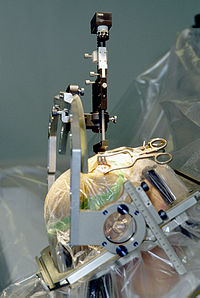
Photo from wikipedia
Intraoperative neuromonitoring (IONM) is a widely used practice in spine surgery for early detection and minimization of neurological injury. IONM is most commonly conducted by indirectly recording motor and somatosensory… Click to show full abstract
Intraoperative neuromonitoring (IONM) is a widely used practice in spine surgery for early detection and minimization of neurological injury. IONM is most commonly conducted by indirectly recording motor and somatosensory evoked potentials from either muscles or the scalp, which requires large-amplitude electrical stimulation and provides limited spatiotemporal information. IONM may inform of inadvertent events during neurosurgery after they occur, but it does not guide safe surgical procedures when the anatomy of the diseased spinal cord is distorted. To overcome these limitations and to increase our understanding of human spinal cord neurophysiology, we applied a microelectrode array with hundreds of channels to the exposed spinal cord during surgery and resolved spatiotemporal dynamics with high definition. We used this method to construct two-dimensional maps of responsive channels and define with submillimeter precision the electrophysiological midline of the spinal cord. The high sensitivity of our microelectrode array allowed us to record both epidural and subdural responses at stimulation currents that are well below those used clinically and to resolve postoperative evoked potentials when IONM could not. Together, these advances highlight the potential of our microelectrode arrays to capture previously unexplored spinal cord neural activity and its spatiotemporal dynamics at high resolution, offering better electrophysiological markers that can transform IONM. Description Two-dimensional maps of human spinal cord activity were generated using high–channel count surface microelectrode arrays. A roadmap of the spine During spinal cord surgery, intraoperative neuromonitoring (IONM) is used to reduce the risk of damage. Electrodes on muscles or scalp record the response to large-amplitude electrical stimuli delivered to the spinal cord. However, this method does not allow precise spatiotemporal characterization of spinal cord neurophysiology. Now, Russman et al. developed a microelectrode array that can be placed on the spinal cord during surgery and record with high spatiotemporal definition and high sensitivity the electrophysiological response to low-current stimulation, providing precise maps of spinal cord electrophysiology. These maps can be used during surgery to improve IONM.
Journal Title: Science Translational Medicine
Year Published: 2022
Link to full text (if available)
Share on Social Media: Sign Up to like & get
recommendations!